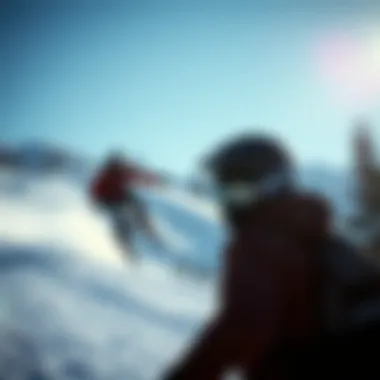The Impact of Outdoor Temperature on Extreme Sports Performance


Intro
When it comes to extreme sports, outdoor temperature is not merely a passive backdrop; it’s a vital player in shaping the experience of athletes. From the soul-stirring chill of a winter’s day to the blazing heat of summer, the temperature affects everything—performance, safety, and even the gear used. Enthusiasts venturing into the wild need to be keenly aware of how external temperature can change the rules of the game.
In this piece, we’re not just scratching the surface. We’ll dive deep into how temperature variations whisper secrets about how and when to push the limits of athletic performance responsibly. Let's unpack the physical reactions of our bodies to these temperature shifts and examine equipment that might otherwise blend into the background. Understanding these elements will prepare you for the great outdoors, making every adventure just a little bit smarter.
What do we have in store? A comprehensive guide spanning equipment, techniques, safety, events, and the vibrant community surrounding extreme sports. By exploring these topics, we hope to provide a roadmap for both seasoned pros and beginners alike, ensuring that every thrill is met with the right knowledge and gear. So, let’s get started, shall we?
The Significance of Temperature in Outdoor Environments
When discussing extreme sports, the importance of outdoor temperature can't be overstated. It's like the weather gods holding the reins to a thrilling adventure. Knowing how the temperature influences our environment helps not just in achieving excellent performances but also in ensuring the safety of athletes. In this section, we'll break down what outdoor temperature means and dive into its essential role in extreme sports.
Defining Outdoor Temperature
Outdoor temperature refers to the measure of how hot or cold the air is outside, impacting everything from our comfort levels to how equipment performs. It’s more than just a number on a digital thermometer; it encompasses several factors such as humidity, wind chill, and even solar radiation. For instance, in a chilly mountain environment, -5°C can feel drastically different when a biting wind picks up compared to a still, sunny day at the same temperature.
Understanding temperature also involves appreciating its specifics. Is it dry heat or humid? Is the air so cold that it numbs the fingertips? Each type affects performance and endurance in unique ways. To truly appreciate outdoor activities, a nuanced grasp of temperature conditions becomes essential—one that every extreme sports enthusiast should master.
The Role of Temperature in Extreme Sports
Temperature plays a pivotal role in extreme sports for multiple reasons, ranging from performance optimization to safety measures. Here’s why:
- Performance Impact: As temperature fluctuates, so does the body’s physiological response. In hot conditions, for instance, the body has to work harder to cool itself, which can lead to exhaustion or heat-related illnesses. On the flip side, cold temperatures can result in diminished muscle function and increased risk of sprains or injuries.
- Equipment Functionality: Many sports depend heavily on specialized gear, which performs optimally only under certain temperature ranges. For example, in snowboarding, soft snow in warmer temperatures may lead to slower rides due to increased resistance. Gear designed for colder environments, whether that is insulation in jackets or the type of skis used, has a well-defined temperature range for optimal performance.
- Safety Concerns: Athletes must be vigilant of temperature extremes that could pose health hazards.
"Extreme temperature variations can turn a thrilling descent into a veritable game of survival." For instance, hypothermia is a genuine risk when adventuring in frigid climates. Conversely, heat exhaustion looms large in scorching conditions. Understanding the stakes allows athletes to prepare adequately, ensuring their adventures remain exhilarating rather than dangerous.
In essence, the intersection of outdoor temperature and extreme sports creates a unique landscape that every athlete must navigate. Anticipating fluctuations in temperature and adapting strategies accordingly not only makes for better performance but ultimately enriches the overall experience of the sport.
Physiological Responses to Temperature Changes
Understanding how our bodies react to temperature is crucial, especially for those drawn to extreme sports. These activities push physical limits, demanding not just skill and mental acuity, but also an attunement to bodily responses under varying thermal conditions. An athlete’s performance and overall safety hinge on their awareness of how temperature fluctuations impact physiological processes.
During extreme sports, temperature conditions can lead to a spectrum of bodily responses—from optimized performance to potential hazards like heat-related illnesses or hypothermia. Ignoring these effects can turn an exhilarating experience into a perilous one, making it essential for athletes to grasp the underlying science of thermoregulation.
Effects of Heat on Athletic Performance
When it comes to heat, performance optimization takes center stage. An increase in external temperature can temporarily elevate an athlete's basal metabolic rate, which might sound advantageous, but it often complicates matters.
As the heart races to supply more blood to the muscles and skin to dissipate heat, a range of physiological effects unfold:
- Increased heart rate: Under thermal stress, the heart rate may rise considerably, impacting endurance and stamina.
- Dehydration risks: Excessive sweating can lead to the depletion of vital fluids and electrolytes, which are essential for muscle function and endurance.
- Strategies for heat acclimatization: Athletes can adapt to heat over time, improving performance through methods such as gradual exposure and conditioning workouts designed for warm climates.
To sum it up, understanding how extreme heat affects athletic capabilities isn't just icing on the cake—it's the whole damn cake. Athletes who grasp these concepts gain a crucial edge.
Hypothermia and Cold Weather Challenges
On the flip side is the chilling grip of cold temperatures, where hypothermia becomes a very real threat for outdoor athletes. Hypothermia occurs when the body loses heat faster than it can produce it, leading to internal temperatures dropping to dangerously low levels. The implications of this are stark:
- Impaired motor skills: Coordination suffers as the body struggles to maintain core temperature, significantly hampering an athlete’s performance.
- Increased risk of frostbite: Extremities are particularly susceptible to the cold, making awareness and protection vital—frostbite is no small inconvenience.
- Clothing and shelter strategies: Proper layering techniques can stave off cold-related issues. Utilizing moisture-wicking materials as first layers, insulated middle layers, and windproof outer layers creates a barrier against frigid winds.
Athletes need to be proactive in monitoring their condition in low temperatures. Just as with heat, awareness of your body's capabilities and limitations can mean the difference between success and a severe health crisis in cold conditions.
"The body is a temple, but it’s also a machine that operates best within specific temperature limits. Respect it, or pay the price."


Equipment Considerations for Varying Temperatures
Selecting the right equipment is crucial when partaking in extreme sports, especially as temperatures fluctuate. Different climates not only affect an athlete's performance but also their safety. Having the right gear can be the difference between success and an uncomfortable, even hazardous, experience. In this section, we will explore key factors that influence equipment choice, highlighting how gear adapts to varying temperatures and the consequential benefits.
Choosing the Right Gear for Cold Conditions
When you're tackling icy peaks or navigating through snow-packed terrain, having the appropriate gear for cold conditions can make a world of difference. This isn't just about comfort; it directly correlates to your performance and safety.
- Insulation is Key: Cold environments require layers that trap heat. Insulated jackets made from materials like down or synthetic fibers are paramount. They provide warmth without bulk, allowing for greater freedom of movement.
- Moisture Management: If sweat builds up under layers, it’s not long before you're feeling cold from a damp shirt clinging to your back. Look for baselayers that wick moisture. Merino wool is frequently a favorite because it keeps warmth while staying comfy against the skin.
- Windproof and Waterproof Protection: Extreme cold often comes with windy conditions or sharp precipitation. Thus, your outer layer should be windproof and waterproof. Consider jackets with Gore-Tex membrane or similar technology, as these materials offer both breathability and protection.
- Footwear Matters: Cold feet can be unbearable. Insulated, waterproof boots are a wise investment. While choosing your footwear, consider not just warmth but grip as well, especially when maneuvering on slippery surfaces.
- Accessories that Count: Don't overlook the essentials like gloves, hats, and neck gaiters. Every part of the body can lose heat, so covering extremities is essential. Thicker gloves for climbing or skiing can give you the rigidity needed, while lightweight gloves work for less demanding conditions.
Remember: If your extremities are cold, your entire body will feel it. Prioritize gear that keeps your hands and feet warm.
Heat Management in Hot Weather Gear
On the flip side of the temperature scale, extreme sports enthusiasts also need to be prepared for the sweltering heat. Optimal performance in high temperatures entails smart choices in gear that promotes cooling and hydration.
- Lightweight Materials: Opt for clothing made from lightweight, breathable materials. Polyester blends and moisture-wicking fabrics are ideal, as they help pull sweat away from the skin, keeping you cool under pressure.
- Ventilation Features: Look for garments with mesh zones or vent openings. These can allow for better airflow, reducing the chance of overheating while climbing or biking under the scorching sun.
- Sun Protection: Long-sleeve shirts or high-UPF fabrics offer protection against harmful UV rays. It’s essential to consider skin safety alongside comfort.
- Hydration Packs: Keeping hydrated can become tricky in extreme heat. Wearing a hydration pack can facilitate easy access to fluids without slowing you down. Make sure it’s lightweight and designed to hold sufficient water for your activity duration.
- Cooling Accessories: Things like cooling towels or headbands can offer immediate relief. These items can absorb water and provide cooling effects when needed.
For practical guidance and gear reviews, check out outdoor retailers like REI or Backcountry.
Safety Precautions for Temperature Variability
Understanding the implications of fluctuating temperatures is vital for the safety of those engaged in extreme sports. Extreme athletic endeavors are often conducted in unpredictable environments, where temperature can swing drastically. Without proper precautions, the risks can outweigh the thrill. Beyond just performance, ensuring safe engagement with outdoor activities means recognizing the environmental factors that come into play. This section discusses two primary safety strategies: hydration in hot weather and layering techniques for cold climates.
Hydration Strategies in Hot Weather
When the mercury rises, hydration becomes your best bud. Let’s face it, no one wants to be that athlete who struggles to keep it together on a scorching day. Sweat does wonders for cooling the body, but it also takes away essential fluids and electrolytes necessary for endurance.
Key Considerations:
- Monitor Fluid Intake: Aim to sip continually rather than gulping down water. Some experts suggest nearly an ounce for every 10-20 minutes, especially during intense physical activities.
- Electrolytes Matter: Plain water can be insufficient under extreme conditions. Consider drinks that contain electrolytes to recharge those lost minerals.
- Know When to Stop: Pay attention to the signs of dehydration—dry mouth, fatigue, and dizziness are no good for anyone. Stop and hydrate immediately.
Using timing as a guide can also be a game-changer. Try to plan your activities for early morning or late evening when temperatures are cooler. This move not only enhances safety but also optimizes performance.
"An ounce of prevention is worth a pound of cure." — Benjamin Franklin
Layering Techniques for Cold Environments
When the chill sets in, many athletes can find themselves caught between a rock and a cold place if they don’t dress right. Cold weather presents a unique set of challenges, and the importance of appropriate layering cannot be overstated. Proper layering acts as a shield against the biting cold while allowing movement and flexibility.
Effective Layering Steps:
- Base Layer: This should hug your skin like a second layer but not too tight! Look for moisture-wicking fabrics to keep sweat at bay.
- Mid Layer: Think of this as your insulation—opt for fleeces or down jackets that trap heat effectively. They should also allow for ease of motion.
- Outer Layer: Windproof and waterproof options provide protection against the elements. This could include shell jackets that keep you safe from wind and precipitation.
- Accessories: Don’t forget your extremities! Wear insulated gloves, thermal socks, and a beanie to keep your body heat from escaping.
- Adapt as Needed: The great outdoors is nothing if not dynamic. Adjust your layers based on activity levels and environmental changes.
Summing it up, the right layering can transform a potentially dangerous situation into an enjoyable experience. Now, you can focus on your adrenaline-pumping action rather than feeling like a popsicle!
These strategies create a safety net against temperature variability, allowing athletes to push their limits knowledgeably. In any extreme sport, preparation is paramount. Keep these practices at the forefront of your mind as they form the bedrock of safe adventures.
Regional Climate Impacts on Extreme Sports
Understanding the regional climate impacts on extreme sports helps athletes and enthusiasts grasp how diverse weather patterns can dictate their activities. Each region presents its unique temperature characteristics, which directly correlate with the suitability of specific sports. Extreme sports are often reliant on both predictable and unpredictable weather conditions; thus, comprehending these impacts ensures preparedness and safety.
Several factors influence how climate variation affects outdoor sports, from topographical shifts to seasonal weather transitions. Regions renowned for certain sports can see alterations that either extend or limit the availability of activities.
Temperature Trends in Mountain Climbs


In the world of mountain climbing, temperature trends play a critical role in safety and performance. For instance, as climbers ascend, the air typically becomes colder. But unexpected temperature shifts can occur due to factors like elevation changes, time of day, and local weather anomalies. As a climber prepares to tackle peaks, awareness of what the temperature will be at various altitudes is vital.
When planning a climb, here are a few key points to consider:
- Layering: Different temperatures require appropriate attire to regulate body heat. For example, temperatures can drop significantly as one approaches the summit during early morning expeditions.
- Weather Forecasting: Real-time data and high-resolution forecasts help climbers dodge sudden storms or avalanches, which are often linked to rapid temperature changes.
- Hydration Concerns: Surprisingly, hydration remains crucial even in cold weather, as dehydration can sneak up on climbers. Cold air draws moisture from the body, necessitating regular fluid intake.
"Adapting to the mountain climate is as important as mastering the climb itself. One incorrect assumption about temperatures can lead to dire consequences."
Differential Effects on Coastal and Temperate Activities
Conversely, coastal and temperate regions hold their unique set of challenges for extreme sports. While temperatures along the coast may seem consistent, they can still fluctuate dramatically due to maritime influences. For instance, athletes engaging in surfing or kiteboarding need to be mindful of the sea surface temperatures, which can provide varying energy levels for waves.
In temperate zones, where sports like trail running or mountain biking thrive, the relationship between air and ground temperature affects performance. Warm days can lead to dry, hard-packed trails while rain can create muddy, slippery conditions.
Several things to keep in mind:
- Predictive Models: Using regional climate models can help athletes plan their endeavors. These models provide insights into expected trends in temperature and precipitation.
- Equipment Specific to Weather: For surfing, the choice of wetsuit can significantly influence both comfort and performance. Selecting the right thickness based on water temperature is essential.
- Local Knowledge: Engaging with local communities provides invaluable insight into regional variations. Locals can offer tips on how weather changes influence particular spots for extreme sports.
Navigating outdoor sports in different climates does not merely involve understanding weather patterns, but also thinking critically about environmental conditions. The more informed athletes are about these aspects, the better equipped they will be to adapt and thrive even in the face of climate variability.
The Influence of Climate Change on Outdoor Sports
Climate change is not just a buzzword tossed around at dinner parties; it’s a glaring reality that reshapes the landscape of outdoor sports. Understanding its implications has never been more important, especially for those who thrive on the edge, pursuing activities like snowboarding, mountain climbing, and surfing. The interplay between climate change and sports is intricate and multifaceted. With rising temperatures and fluctuations in weather patterns, it casts a shadow over the once predictable realms of outdoor adventure.
Impact of Global Warming on Snow Sports
The effects of global warming extend far into winter sports, which rely heavily on consistent snowfall and cold temperatures. In recent years, ski slopes that once proudly boasted powdery slopes find themselves lacking coverage, with patches of brown earth showing through, signaling the challenges ahead. According to data, ski and snowboard seasons have been shortened by an alarming margin in many regions.
- Loss of Natural Resources: Glaciers that once served as natural ski parks are shrinking, affecting not just the activities but also local economies that depend on winter sports tourism.
- Unpredictability: Those thrilling descents that once promised fresh snow may now feature icy conditions or, alternatively, slushy messes that sap energy and joy from athletes.
- Impact on Training: Athletes preparing for competitions face difficulties in accessing reliable training terrains, resorting to artificial snow, which, while a solution, doesn’t replace the real deal.
"Without snow, there’s no growth in this sport; we risk losing not just venues, but a lifestyle," a veteran snowboarder emphasized during a recent summit on climate and sports.
Adapting Strategies for Changing Conditions
Adaption, in the face of uncertainty, emerges as a crucial theme for extreme sports enthusiasts. This necessitates not just a reaction to current conditions but a proactive approach. Here are some evolving strategies that athletes and organizations can embrace:
- Diversification of Venues: Seeking alternative locations may become more common. Instead of focusing solely on traditional spots, athletes might explore lesser-known areas or even countries with stable climates, thus broadening their horizons.
- Advanced Technologies: Utilizing cutting-edge weather tracking tools and apps enables athletes to stay informed about changing conditions, allowing for last-minute adjustments to plans.
- Collaborative Efforts: Connecting with local communities and environmentalists can inspire changes in policy that protect snow and ice resources, which ultimately benefits everyone in the outdoor sports sector.
- Training Adaptations: Off-snow training programs and simulations are becoming vital. Athletes can develop performance metrics in environments that offer consistent conditions, ensuring readiness for whatever Mother Nature throws their way.
Preparing for Outdoor Activities: A Strategic Approach
Engaging in extreme sports requires more than just thrill-seeking; it demands careful preparation, particularly when it comes to outdoor temperature considerations. For athletes who find joy in activities like snowboarding, mountain climbing, or trail running, understanding how temperature impacts their performance and safety is paramount. Strategic preparation involves anticipating weather conditions, selecting appropriate gear, and honing skills to adapt to temperature fluctuations. Each decision plays a vital role in ensuring that the experience is not only exhilarating but also safe.
Weather Forecast Analysis for Planning
Monitoring weather forecasts is crucial for anyone aiming to enjoy outdoor sports. The first step in preparation is to check reliable meteorological sources. By keeping tabs on local forecasts, athletes can make informed decisions that could significantly enhance their outdoor experience.
- Temperature Projections: Knowing the expected highs and lows helps in determining what to wear and how to hydrate. For instance, running in the midday sun can be a different ballgame compared to an early morning jog when temperatures are cooler.
- Wind Chill Factors: Especially pertinent for activities in cold climates, wind chill can drastically lower perceived temperatures. Athletes need to factor that into their plans and gear choices to avoid underdressing.
- Precipitation Forecasts: Rain or snowfall can alter conditions rapidly. For snow sports enthusiasts, a fresh blanket of powder might be tempting, but wet snow can mean increased risks of avalanches or slippery conditions. Understanding these forecast details helps in strategizing appropriate timing for activities.
It is wise to avoid the temptation of relying solely on apps for weather updates. Rely on several platforms or meteorological services to get a clearer picture and cross-verify forecasts. The old saying goes, "Trust but verify."
Creating a Gear Checklist Based on Conditions
Once the weather forecast is assessed, organizing a gear checklist is next. This list ensures that no essential item is left behind and that all gear is suitable for the expected outdoor conditions. Here are some considerations:


- Cold Weather:
- Hot Weather:
- Miscellaneous:
- Insulating Layers: Base layers, mid-layers, and outer shells should provide the right balance of warmth and moisture-wicking capabilities. A common choice is to wear merino wool for base layers due to its excellent thermal properties.
- Accessories: Hats, gloves, and thicker socks can help prevent heat loss, particularly during prolonged exposure.
- Lightweight Clothing: Breathable fabrics can make the difference between an enjoyable day and a sweaty slog. Fabrics like polyester or nylon designed for moisture management are favorable.
- Sun Protection: Sunscreen and sunglasses are non-negotiables to protect against UV rays, especially in high-altitude regions where exposure is heightened.
- Hydration Packs: Staying hydrated is vital in both hot and cold conditions. A hydration pack can provide easy access to fluids during activity.
- Emergency Items: Packing a first-aid kit, portable weather radio, and navigation tools could stave off peril in unexpected situations.
Navigating through the unpredictable realms of nature is not just about the adrenaline rush; it hinges on preparedness. A gear list tailored to environmental conditions can significantly mitigate risks, ensuring that moments spent indulging in extreme sports are memorable for all the right reasons.
"Preparation is the key to success. Without it, the only thing left is the chance of failure."
Post-Activity Recovery in Relation to Temperature
Recovery following extreme sports activities cannot be overlooked. It is during this period that the body undergoes vital processes to repair, rehydrate, and restore its balance after a strenuous endeavor. The importance of temperature in this recovery phase shapes not only immediate comfort but also long-term athletic performance.
The deceiving calm that follows the adrenaline rush of climbing, surfing, or snowboarding can be a double-edged sword. Immediate responses to heat or cold directly affect how well an athlete recovers. For instance, neglecting temperature considerations may lead to detrimental effects on muscle recovery, hydration status, or risk of injury recurrence. Here, it is important to understand how cooling down and warming up strategies vary depending on the conditions encountered.
Cooling Down After Extreme Heat Activities
Post-activity cooling during hot weather is critical. Whether participating in a grueling marathon in desert heat or enduring hours of rock climbing under relentless sun, the body generates significant heat. Hydration is not enough on its own; the body must be effectively cooled down to avoid heat exhausation or heat stroke.
- Transition Slowly: Once finishing an outdoor activity, allow for at least 10 to 15 minutes of light walking to help the body’s core temperature gradually normalize.
- Hydration choice matters: Drink electrolyte-rich fluids. Simple water may suffice in daily life, but when battling the sun’s heat, sports drinks can replenish lost salts and minerals.
- Seek Shade: Find a cool and shaded area to help facilitate natural recovery. Utilize items like cooling towels or even ice packs on pulse points such as neck and wrists to expedite cooling.
- Light Clothing Helps: Wearing breathable and light-colored clothing can assist the body in regulating temperature even after activities.
- Duration of Recovery: Ideally, take about 30 minutes to an hour for your body to cool down completely before focusing on deeper stretching or eating significantly.
Warming Recovery Techniques for Cold Weather
Contrarily, in cold weather environments, recovery takes on a different approach. The aftereffects of being exposed to cold conditions during sports like skiing or snowshoeing can predispose the athlete to hypothermia. Therefore, the aim is to increase body temperature and promote blood flow.
- Re-layer Carefully: Start by adding layers that act as insulators like fleece or wool immediately after returning from the cold.
- Warm Drinks are Essential: Sip on hot beverages, particularly those rich in carbohydrates and electrolytes; they not only warm you up but also restore energy.
- Gentle Movements: Engage in light activity—think walking or gentle stretching—to stimulate circulation. Vigorous exercise may lead to increased heat loss, which is counterproductive.
- Utilize Warm Baths or Showers: Taking a warm bath can speed up the process of warming the body, while also aiding muscle recovery.
- Immediate Nutrition: Consume a carbohydrate-rich meal to replenish energy stores which might be depleted during the activity.
"In the face of extreme temperatures, the body’s resilience and adaptability can be pushed to the limits. Understanding how to manage post-activity recovery is not just a luxury; it's a necessity for extreme athletes who seek peak performance."
Understanding these recovery methods in relation to outdoor temperature lays the foundation for safer and more effective athletic endeavors. Keep in mind that the elements don’t just influence the performance; they significantly determine how you bounce back after pushing the limits of your body.
Proper post-activity recovery strategies—tailored to temperature conditions—can foster resilience and pique overall performance.
Future Trends in Outdoor Temperature Research
The exploration of outdoor temperature has become increasingly crucial in the context of extreme sports. As climate dynamics evolve, understanding these implications is key for athletes, equipment manufacturers, and safety personnel alike. By analyzing future trends in outdoor temperature research, we can glean important insights that affect not only the performance of athletes but also their overall safety. Emerging practices in temperature monitoring and community-driven studies are reshaping how we approach outdoor activities in varying climatic conditions.
Innovations in Temperature Monitoring Technology
In the fast-paced world of extreme sports, having accurate, real-time data on temperature can be a game changer. Studies have shown that fluctuations in temperature can directly influence an athlete's performance and safety. Enter innovations in temperature monitoring technology, which offer cutting-edge solutions.
For instance, wearable sensors can now track a variety of environmental factors, including humidity levels and wind chill. This allows athletes to make real-time decisions based on immediate data rather than relying solely on pre-existing forecasts.
- Wearable Technology: Devices like smartwatches and specially designed fitness bands now come integrated with temperature sensors.
- Portable Weather Stations: Compact and easy to set up, these devices can monitor temperature shifts in remote locations.
- Mobile Applications: With an array of outdoor-specific apps, athletes can access localized weather info, ensuring they stay ahead of any impending weather changes.
"Real-time data translates to safer, more informed decisions, reducing the risk of injury or hypothermia during critical moments in extreme sports."
With these advancements, athletes can adapt on the fly, enhancing their overall performance and safety standards during competitions or personal challenges.
Community and Impact Studies in Extreme Sports
Beyond technology, there is growing momentum for community-driven research which focuses on understanding the implications of temperature variations within extreme sports. These studies delve into how local climates affect specific sports, fostering a grassroots approach to athlete training and safety.
The role of cognitive awareness is paramount; athletes are often immersed in communities that share insights about climatic changes and their impacts. A few key areas of focus for these studies include:
- Local Climate Adaptation: How do local regions adapt their sports practices based on temperature extremes? For instance, sports such as skiing or surfing often change dramatically based on seasonal variations.
- Safety Protocol Improvements: Communities developing better safety protocols based on temperature data, ensuring that all athletes are prepared for the unexpected.
- Environmental Awareness: Fostering a sense of responsibility toward climate change, encouraging extreme sports communities to advocate for sustainable practices.
These collaborative efforts not only benefit immediate participants but also pave the way for future generations. With input from a diverse pool of athletes and researchers, the understanding of temperature impacts in extreme sports can evolve, leading to safer practices and sustainable engagement with these activities.















